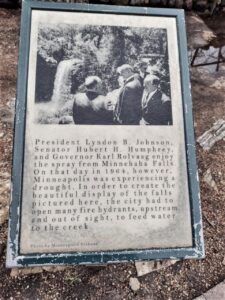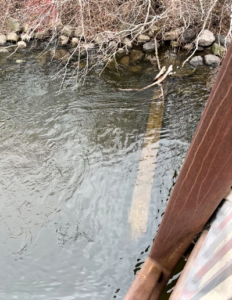
The plaque near the bridge over Minnehaha Creek by the falls. (Photo/Bonnie Oldre)
BY ED FELIEN
In last month’s editions of Southside Pride we published “Swamp creatures rise from the dead.” I wrote:
“That changed in 1964 when (according to the story believed in South Minneapolis) Vice President Humphrey wanted to please his boss, LBJ, with the sight of a full-flowing Minnehaha Falls—even though the creek was low at that time of year and there wasn’t much water. So, he got the U.S. Army Corps of Engineers to back it up with the dam/weir at 27th Avenue to guarantee a good supply of water for the president’s visit. LBJ never came to see the Falls, and we’re stuck with the unintended consequences.”
Readers wrote in:
“Why’d you write that LBJ never visited Minnehaha Falls? There’s a picture of him and HHH and Gov. Rolvaag right by the rock wall.”
“I think you oughta update your column.”
And then, Bonnie Oldre
sent in the photo of the plaque.
Under the photo, it says:
“President Lyndon B. Johnson, Senator Hubert H. Humphrey and Governor Karl Rolvaag enjoy the spray from Minnehaha Falls. On that day in 1964, however, Minneapolis was experiencing a drought. In order to create the beautiful display of the falls pictured here, the city had to open many fire hydrants, upstream and out of sight, to feed water to the creek.”
OK, sorry.
My bad.
The “story believed in South Minneapolis” was wrong. LBJ did show up to witness the spectacle of a full, raging Minnehaha Falls in the middle of a drought. Humphrey wanted to impress LBJ. If the photo was taken before the August Democratic National Convention, then Humphrey was still trying to convince LBJ to pick him as his running mate.
As the former mayor of Minneapolis, he knew who to talk to about opening up the fire hydrants. But it would take too long for that water to reach from the storm sewers on 31st Street to the storm sewer outlet on Lake Hiawatha. Even if they opened all the hydrants from Chicago Avenue over to 27th Avenue it wouldn’t come in a rush strong enough to create a dramatic waterfall. So someone must have come up with the bright idea to dam up the water in Lake Hiawatha. They had extra boards put in to raise a wall of water to seven feet above the floor of Minnehaha Creek. Then, when they knew LBJ was on his way to the falls, they took out the top boards, shortened the dam by two feet and let about 40 million gallons of water rush down Minnehaha Creek the few blocks to the falls.
The photo on the plaque shows a triumphant Humphrey behind LBJ’s back, confident that he’s provided a fitting homage to a visiting emperor.

The dam/weir at 27th Avenue holding back five feet of water
The unintended consequence of permanently blocking five feet of water trying to leave Lake Hiawatha is that the added water will seep into the porous peat soil, raise the water table and saturate the ground around Lake Hiawatha. This will, in turn, affect drainage of the porous peat soil around Lake Nokomis, and when that soil becomes saturated, sinkholes will collapse sidewalks and the groundwater will seep into neighborhood basements.
I wrote to the DNR (Minnesota Department of Natural Resources) and asked them, “Can you please send me a copy of the permit the Minneapolis Park Board has to maintain the dam/weir at 27th Avenue and 47th Street in South Minneapolis that blocks water from Lake Hiawatha to exit into Minnehaha Creek.”
I wrote to the Minnehaha Creek Watershed District and asked them: “What is the function of the dam/weir at 27th Avenue that blocks the exit of Lake Hiawatha into Minnehaha Creek? What harm would result from the removal of the dam/weir?”
I’m waiting for their response.
I wrote to Kayla Westerlund, Permitting Program Manager for the Minnehaha Creek Watershed District:
“Can you please send me a copy of the permit the Minneapolis Park Board has to maintain the dam/weir at 27th Avenue and 47th Street in South Minneapolis that blocks water from Lake Hiawatha to exit into Minnehaha Creek. My understanding of regulations is that: ‘Federally-owned dams and dams determined by the DNR to be non-hazardous are exempt from the dam safety rules. Dams not subject to the dam safety rules will still require state and federal permits if they involve filling of public waters or wetlands.’
“The dam/weir rises five feet from the floor of Minnehaha Creek. This has filled Lake Hiawatha with more than an additional 80 million gallons of water. Clearly, for that extensive an operation, the Department of Natural Resources would have required a permit. Would the Minnehaha Creek Watershed District require a permit as well?
“We are requesting to see a copy of that permit.”
No response.
I wrote to the Park Board:
“Dear Superintendent Bangoura:
“Can you please send me a copy of the permit the Minneapolis Park Board has to maintain the dam/weir at 27th Avenue and 47th Street in South Minneapolis that blocks water from Lake Hiawatha to exit into Minnehaha Creek? My understanding of regulations is that: ‘Federally-owned dams and dams determined by the DNR to be non-hazardous are exempt from the dam safety rules. Dams not subject to the dam safety rules will still require state and federal permits if they involve filling of public waters or wetlands.’ The dam/weir rises five feet from the floor of Minnehaha Creek. This has filled Lake Hiawatha with more than an additional 80 million gallons of water. Clearly, for that extensive an operation, the Department of Natural Resources would have required a permit.
“Could you also tell me the date the dam/weir was put into operation?”
I filled out a Data Response form.
No response.
I wrote to the Park Commissioner for the district:
“Hi Commissioner Musich,
“Can we agree that the water table for the Nokomis/Hiawatha communities is dangerously high?
“Can we agree with the Barr Engineering Study that removing the 27th Avenue dam/weir would lower the level of Hiawatha Lake (and eventually the surrounding water tables for the Hiawatha/Nokomis communities) by one to two feet?
“Will you support removing the dam/weir at 27th Avenue?”
No response.
The city of Minneapolis sponsored a study by the University of Minnesota, “Lake Nokomis Groundwater and Surface Water Evaluation,” that asked, “What is causing high water issues in South Minneapolis? What can be done to mitigate these issues?” The result of the study was (typical of academic studies) we need more study.
Maybe the answer could be that there is a dam/weir at 27th Avenue that is holding back five feet of water and we could mitigate those issues if we took down the dam/weir.
Or is that too obvious?
























